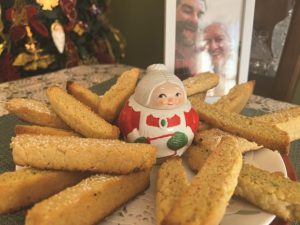It’s a terrible thing to say about one’s grandmother — especially one’s Italian-American grandmother — but mine was not a great cook. Her specialty was a swamp-like egg drop soup with escarole that my family still serves, dutifully, at Christmas dinner every year, and which I have never mustered the requisite nostalgia to enjoy. We still reminisce semi-fondly about the time she made spaghetti with a tomato juice-based sauce, apparently under the influence of some woefully misguided Weight Watchers recipe.

Filamena Amicucci (it seems to me rather a shame everyone called her Fay), my mother’s mother, died at 101 two years ago. She is lovingly remembered for many things: her laugh, her faith, her sparkly sweaters, her crafting talents. But most of the things she served for dinner are not among them.
She was, however, a respectable baker. Her pound cake is still the standard by which I judge the genre. And there were always dozens of her biscotti on hand throughout the year — especially during the weeks between Thanksgiving and New Year’s — stuffed into vintage Tupperware containers and carefully packed into old Danish butter cookie tins lined with wax paper.
Another thing my grandmother did well was write things down. She worked in the parish rectory for more than 50 years, and some of my earliest memories involve watching her write weekly church offering tallies and shopping lists with neat penmanship on lined legal pads for the various monsignors and priests. I haven’t been able to find the recipe for that pound cake, but we’re all lucky that she took the time to write down how to make her biscotti. (“Bisquits,” she wrote on her recipe card — her approximation of how the word was pronounced in the Neapolitan-inflected dialect she grew up speaking: biscott’.)
These are not fancy cookies, certainly not the white chocolate-dipped biscotti that fill apothecary jars on the counters at aspirational coffee shops and sell for four bucks a pop. They do not Instagram attractively. They tend to crumble easily, which means you’ll end up eating about a quarter of every batch in pieces as you remove them from the baking sheet. (Which is actually a good thing, since broken cookies have been scientifically proven to be less caloric than whole ones.) The taste of anise — common in so many southern Italian desserts but rarely anyone’s favorite flavor — is subtle, more of a background theme than a punchy chorus. They are, though, in their simple and unfussy way, just about perfect, either on their own when you want something just kind-of-sweet or especially when dunked, quickly, into a mug of milky coffee or tea.

They are also easy to make; you probably have most of the ingredients on hand already. And I can promise they’ll be disproportionately appreciated by anyone who’s lucky enough to receive a batch of them, so they come in very handy for last-minute holiday giving.
It’s probably a cliché to use the word “Proustian” here, but the taste and texture of these really do transport me back to my grandma’s kitchen in Yonkers. Here’s hoping they become a holiday tradition for you, too.
Fay’s ‘Bisquits’ (Anise Biscotti)
1 cup sugar
3 eggs
1 cup oil (Fay specifies Wesson oil here, though my aunt’s version, which uses 1½ cups of sugar and produces a slightly crunchier cookie than my grandma’s, whose are more cakelike, specifies Mazola. Let the contents of your pantry be your guide.)
3 cups flour
1 Tbsp. baking powder
1 Tbsp. anise extract (The original recipe says “half a bottle of anise extract”; I learned the hard way that extract bottle sizes haven’t been consistent over the years.)
- Heat oven to 350° F.
- Mix all ingredients well. (Fay didn’t specify, but I usually add the sugar, beaten eggs, and extract to the oil, mix the dry ingredients together, and then combine everything in the biggest mixing bowl I have.) You will wind up with something that looks like a lump of oily Play-Doh, but do not be discouraged. Fay knew what she was doing.
- Divide dough into three parts and shape each one into a log approximately 9 in. long and 4 in. wide. Bake the logs (I use parchment paper-lined baking sheets, but the oil in the dough should prevent sticking regardless) for 15-20 minutes until the surface is just firm but the logs are still quite soft.
- Remove from oven and slice each log into ¾-inch slices, laying each piece on its side and spreading them apart a bit on the baking sheet. Return to oven for about 10 minutes until they are nicely golden brown. (You have now baked them twice, which is what biscotti means in Italian. Now you know!)
- Cool on wire racks and sprinkle with confectioner’s sugar or colored sugar before neatly layering into wax paper-lined Danish butter cookie tins. Makes 36 biscotti, more or less, depending on how you shaped and cut the dough and how many you break.
Note: While my family eschews any variations on these (in the same way they were dubious about the vegetarian baked ziti I tried bringing to Christmas dinner one year), I’ve had great success fiddling with this recipe. For double chocolate biscotti, substitute vanilla extract for the anise and add a half cup each of cocoa powder and dark chocolate chips to the dough. Sometimes I’ll use almond extract and throw in a half cup each of dried cherries and toasted slivered almonds. And lemon or orange extract with a few tablespoons of grated citrus peel is good, too.



